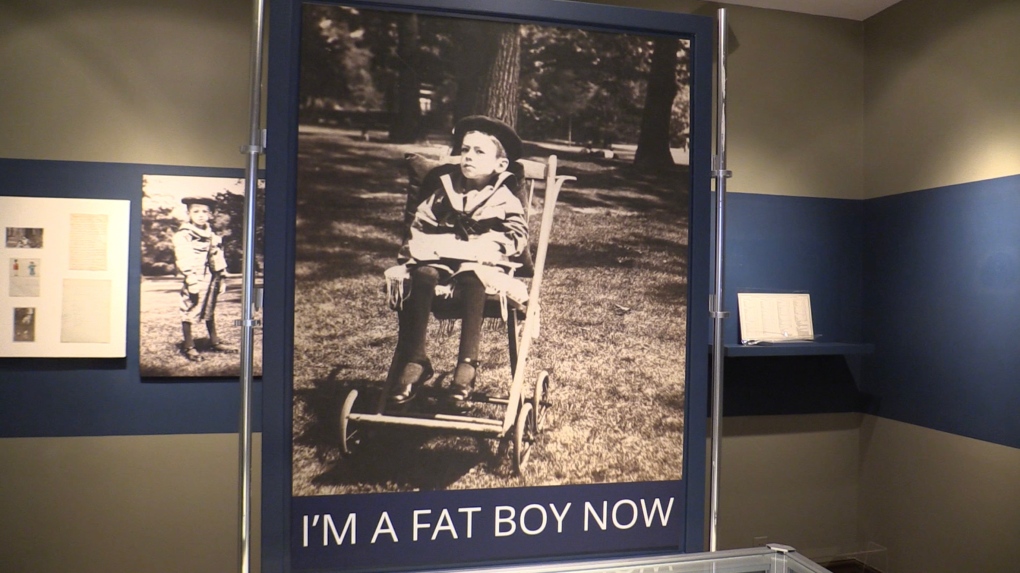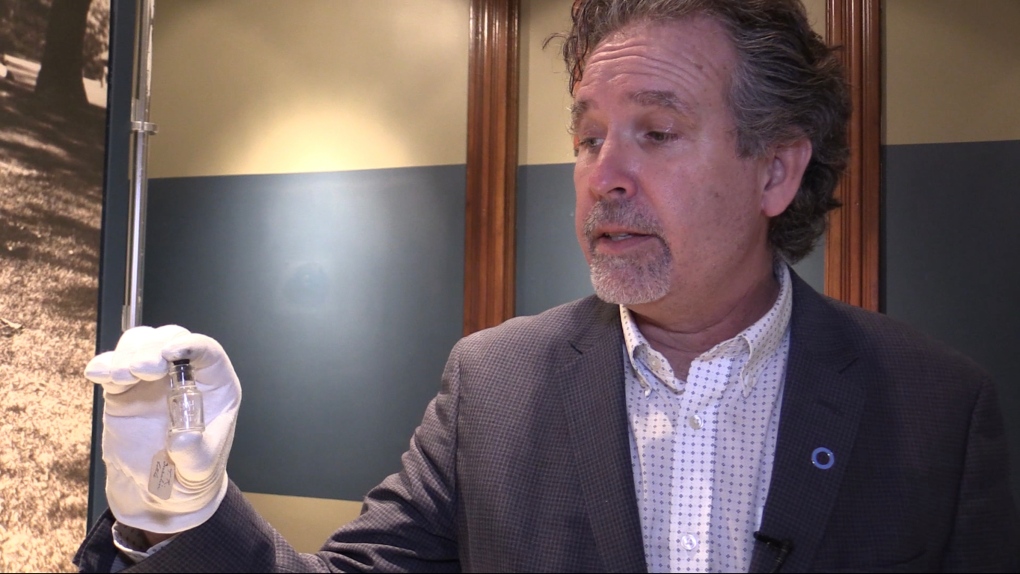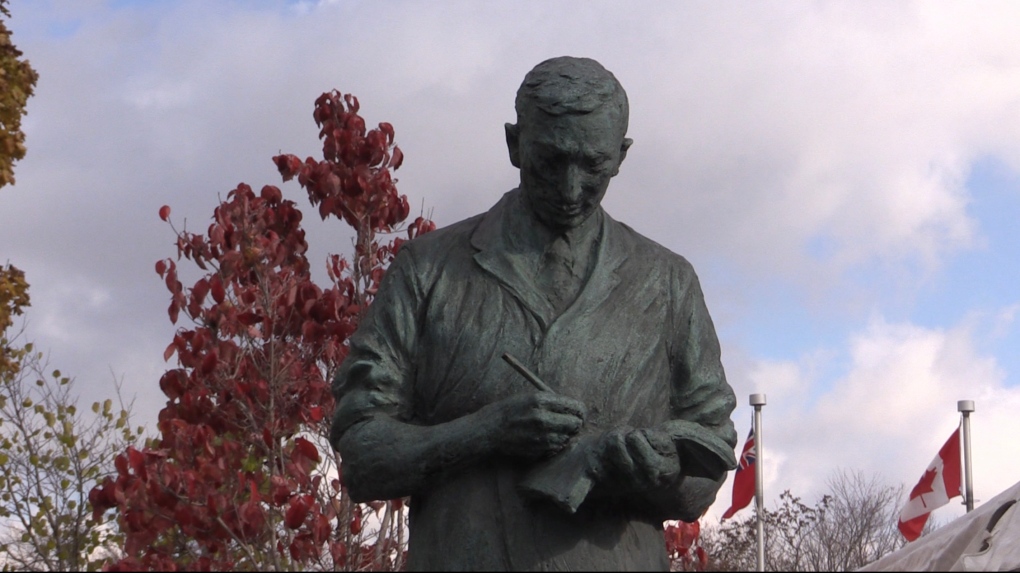'Optimistic for a cure;' Banting House and diabetics celebrate World Diabetes Day
Jennifer Randall is celebrating her 35th "Diaversary" Monday.
The anniversary of the day she was diagnosed with Diabetes comes a day after World Diabetes Day.
"It's just a day to kind of reflect on how lucky I am for the discovery of insulin," says Randall, 40, after taking a tour of Banting House in London, Ont.
"I've been diabetic for 35 years and it’s kind of emotional for me because I know without the discovery of insulin, I probably wouldn't be here.”
Inside Banting House, a national historic site in London, and the former home of Dr. Frederick Banting, curator Grant Maltman is setting up a new exhibition.
"This is Ted Ryder," says Maltman, pointing to a photo of a six-year old boy who weighed just 25 pounds.
"It's July 10, 1922 and that evening he received his first injection of insulin from Frederick Banting. He would die in March of 1993 but lived 71 years on insulin. He was Banting's last surviving original patient.”
 Teddy Ryder, a six-year old boy weighed 25 pounds and was on a 'starvation diet' before Insulin which saved his life, a photo of him shown in Banting House in London, Ont. on Sunday, Nov. 14, 2021. (Brent Lale/CTV London)
Teddy Ryder, a six-year old boy weighed 25 pounds and was on a 'starvation diet' before Insulin which saved his life, a photo of him shown in Banting House in London, Ont. on Sunday, Nov. 14, 2021. (Brent Lale/CTV London)
Maltman felt 100 years after insulin was discovered by Banting in that home, Ryder's story still works today because Insulin remains the only way for diabetics to have a better and longer life.
"We took the title "Fat Boy Now" from a letter that he wrote to Dr. Banting. Before insulin, he was on a starvation diet of under 1,000 calories a day, and within a year of being on insulin he doubled his weight and wrote to Banting telling him, 'I hope you're doing well, I'm a fat boy and can even climb a tree.’”
Banting has saved hundreds of millions of lives over the past century, since his discovery.
"Before insulin was isolated, Diabetes was a death sentence," says Dr. Robert Hegele, a London Health Sciences Centre endocrinologist and researcher.
"Type 1 diabetes, it was just a slow decline but when insulin appeared, it was like a miracle and it's been an absolute gift to the world.”
A century later, there is still no cure but Hegele thinks it’s possible within the next decade research and technology will get them close.
"Transplanting the whole pancreas is probably not going to be feasible," says Hegele.
"Fortunately there's just a small part of the pancreas, maybe five per cent of a specific cell type, the islets of Langerhans within the pancreas, so they're the ones that are responsible for making the insulin. The forefront of research is trying to transplant those islets, injecting the cells and then hoping that they will take and then we'll start producing insulin in place of the islets that were destroyed by an autoimmune disease.”
 Banting House Curator Grant Maltman holds the first vial of insulin given to Teddy Ryder, a six year old boy in 1922. Ryder would live 71 years on insulin discovered by Dr. Fredrick Banting in London, Ont. (Brent Lale/CTV London)
Banting House Curator Grant Maltman holds the first vial of insulin given to Teddy Ryder, a six year old boy in 1922. Ryder would live 71 years on insulin discovered by Dr. Fredrick Banting in London, Ont. (Brent Lale/CTV London)
Hegele feels it’s a slow process, but every year he's seeing progress being made and believes it will be a reality.
"What we're really looking for is that ultimate cure that then, you know, restores life that it would be indistinguishable from somebody who didn't have diabetes,” he says. “Right now you could have a great life and close to normal life, but what we really would be looking for would be that kind of permanent fix, you know, that one shot, permanent correction, that would just bring everything into the mainstream and just allow person with diabetes to carry on with, with a completely normal life.”
That sounds good to both this reporter (I'm a Type 1 Diabetic since 2005) and also to Randall who has been living with the disease since she was five years old.
"I've seen so many changes for the better in technology and opportunities out there and I tend to be optimistic," says Randall.
"We can only go up from here, and the possibilities are endless. I'm still optimistically hopeful for a cure in my lifetime.”
 A statue of Sir Fredrick Banting outside his former home in London, Ont. on Sunday, Nov. 14, 2021. (Brent Lale/CTV London)
A statue of Sir Fredrick Banting outside his former home in London, Ont. on Sunday, Nov. 14, 2021. (Brent Lale/CTV London)
CTVNews.ca Top Stories

BREAKING WikiLeaks' Assange pleads guilty in deal with U.S. that secures his freedom, ends legal fight
WikiLeaks founder Julian Assange has pleaded guilty to a single felony charge for publishing U.S. military secrets in a deal with Justice Department prosecutors that secures his freedom and concludes a drawn-out legal saga that raised divisive questions about press freedom and national security.
One of Canada's most popular vehicles recalled over transmission issue; 95,000 impacted
One of the country's most popular vehicles is being recalled in Canada due to a transmission issue that may impact tens of thousands of drivers.
'We need to regroup,' says Liberal minister and Ontario campaign co-chair in light of byelection loss
A member of Prime Minister Justin Trudeau's cabinet and the party's Ontario co-chair for the next campaign says the Liberals 'need to regroup' after a shocking overnight byelection loss to Pierre Poilievre's Conservatives.
'Truly a great British Columbian': Former B.C. premier John Horgan has cancer again
Former B.C. premier and current Canadian ambassador to Germany John Horgan has been diagnosed with cancer for a third time.
Cup Noodles serves up notoriously poisonous pufferfish
Pufferfish is regarded as a luxury in Japan and a meal featuring the potentially poisonous delicacy can easily cost up to 20,000 yen (US$125) at high-end restaurants.
Pre-med students can't take MCAT in Quebec because of Bill 96
Areeba Ahmed says she's always dreamed of becoming a surgeon but her road to the operating room has become a complicated one ever since Quebec's French language law came into effect.
Electric vehicle infrastructure lags in Prairie provinces
The Prairies, along with Newfoundland and Labrador, trail the rest of the country in electric vehicle (EV) infrastructure.
Protesters try to topple Queen Victoria statue near pro-Palestinian encampment in Montreal
Montreal police were called to intervene after protesters attempted to tear down the Queen Victoria statue at Victoria Square.
Workers rescued after swing stage ropes break outside 56th floor of downtown Toronto hotel
Two workers have been rescued after some of the ropes holding up a swing stage atop a soaring downtown Toronto hotel broke.

































